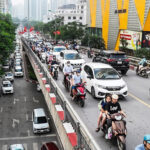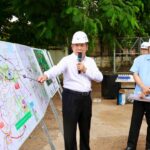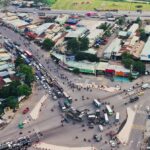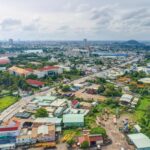Freeway and National Highway Overload
Mr. Nguyen Minh Quan, representing Dai Phat Plastic Company, shared that his company frequently transports goods between Long Thanh, Dong Nai Province, and Ho Chi Minh City. However, this 45-kilometer stretch of road always takes a significant amount of time, especially during weekends.
“On weekends, there is heavy traffic on the Ho Chi Minh City – Long Thanh expressway as people from Ho Chi Minh City and neighboring provinces travel. Additionally, National Highway 51, which connects Ho Chi Minh City and Dong Nai, also experiences heavy congestion. These are the two main routes between Ho Chi Minh City and Long Thanh, but traveling on them is extremely challenging,” Mr. Quan said.

The Ho Chi Minh City – Long Thanh – Dau Giay Expressway often experiences lengthy traffic jams, frustrating residents and businesses. (Photo: Luong Y)
According to Mr. Quan, his company’s cargo trucks typically take at least two hours to reach Long Thanh. On days with severe congestion, it can take up to three hours. This results in increased logistics costs for the business due to the extended time spent on the road.
Representatives of many businesses and residents in Ho Chi Minh City shared that the construction of Long Thanh International Airport is progressing rapidly. However, the transportation infrastructure connecting Long Thanh to Ho Chi Minh City is lagging. If the airport becomes operational soon, the infrastructure will face significant pressure.
In a response to VTC News, Dr. Ngo Viet Nam Son, a planning and architecture expert, stated that the construction of Long Thanh International Airport is on track. The first technical flight is expected to take off from Noi Bai International Airport and land on the runway at Long Thanh on December 19, with commercial operations commencing in the first half of 2026.
The construction of Runway 1 is almost complete, while Runway 2 is being expedited. The passenger terminal has finished its concrete structure, basement, and four floors, and the central steel roof has reached its final height. Currently, the rough construction is more than 95% complete, and it is expected to be finished by August 2025.
However, according to Dr. Son, the progress of regional connectivity infrastructure has not kept pace with the airport’s construction. Despite the airport’s expected opening by the end of the year, the transportation system remains disjointed and incomplete.
Dr. Son analyzed that regional connectivity infrastructure includes three main components: First, the inter-regional expressway system, including routes to Long Thanh and the expansion of the Long Thanh – Dau Giay Expressway.
Second, the roads connecting to the expressway, national highways, provincial roads, and township roads. Third, the railway system, encompassing metro lines (such as Thu Thiem – Long Thanh and Ben Thanh – Bien Hoa – Long Thanh) and high-speed railways, which are planned to have a station in Long Thanh.
“In principle, the progress of regional connectivity infrastructure should match the airport’s construction progress. When the project is completed, all these elements should be in place,” emphasized Dr. Son.
According to Dr. Son, the current situation calls for different priorities regarding regional connectivity infrastructure. For example, when the airport becomes operational, it may not have metro and high-speed railway systems in place during the initial phase due to the time required for their completion. On the other hand, expressway and connecting roads to national highways are mandatory and should be the primary focus, aiming for simultaneous completion with the first phase of the airport.
“I want to emphasize the importance of setting the right priorities. If we don’t complete the regional road and expressway connectivity in time, the airport will struggle to operate effectively even after its inauguration,” shared Dr. Ngo Viet Nam Son.

Dr. Ngo Viet Nam Son, Planning and Architecture Expert. (Photo: D.V)
Dr. Son also suggested that to maximize the efficiency of Long Thanh International Airport, all cargo operations at Tan Son Nhat International Airport should be relocated to Long Thanh. It is essential to construct a cargo terminal at Long Thanh Airport, not just focus on the passenger terminal. By doing so, the cargo terminal can be utilized immediately upon the airport’s opening, providing a significant source of revenue during the initial phase.
According to the expert, with the existing runway, transferring all cargo operations from Tan Son Nhat to Long Thanh would not only enhance the efficiency of Long Thanh Airport (despite the lack of complete connectivity infrastructure) but also provide additional capacity for Tan Son Nhat to address its current challenges. For instance, additional electric bus routes could be established to connect terminals T1, T2, and T3.
Dr. Son emphasized that with the current limited infrastructure, it is not advisable to rush the transfer of all international flights to Long Thanh Airport. A careful consideration of economic efficiency is necessary, as the infrastructure at Tan Son Nhat International Airport, despite some limitations and congestion, is still functioning well.
Therefore, while Long Thanh International Airport is envisioned to become the largest airport in the country in the future, during its first phase, Tan Son Nhat International Airport will continue to play a more critical role.
“Another crucial point is that when considering Long Thanh in the context of regional connectivity, the road network should not only connect Dong Nai and Ho Chi Minh City but also extend to the Mekong Delta and beyond,” Dr. Son added.
Developing Multi-Modal Infrastructure
Dr. Ngo Viet Nam Son asserted that Ho Chi Minh City is evolving into a supercity, and thus, there should be a strategic focus on multi-modal infrastructure connecting different localities.
Firstly, there is a need to construct expressways to facilitate urban and industrial logistics. Secondly, the development of metro lines provides an opportunity to establish transit-oriented development (TOD) urban areas.
Thirdly, direct railway connections between industrial parks in the Ho Chi Minh City supercity and Dong Nai with the Cai Mep – Can Gio port cluster should be prioritized. This mode of transportation is the most cost-effective and efficient, as practiced by many countries with seaports worldwide.
Lastly, inland waterways should be planned to utilize the Dong Nai and Saigon rivers for cargo consolidation, transporting goods to seaports like Cai Mep – Can Gio, Hiep Phuoc, and others. By integrating multi-modal transportation systems, including road, rail, and waterways, logistics efficiency will be enhanced, fostering economic growth.
Dr. Son believes that in the long term, a multi-modal transportation infrastructure system will elevate Long Thanh International Airport to become Vietnam’s largest airport, serving as a hub for direct flights to Europe, the Americas, Australia, and beyond, with a leading position in Asia.
Additionally, Long Thanh Airport will be a central airport for the Ho Chi Minh City region, covering an area of up to 30 kilometers in both Dong Nai and Ho Chi Minh City.
The expert assessed that in the future, Long Thanh International Airport will attain a prominent position nationally and internationally when complemented by appropriate infrastructure and regional connectivity. However, achieving this status will require a long-term plan and gradual development.
In the short term, while the transportation infrastructure is still incomplete, the role of Long Thanh International Airport in the first phase should be viewed realistically. It should be positioned as a supporting airport to alleviate congestion at Tan Son Nhat, rather than hastily assuming the role of a “central aviation hub” or requiring all international flights to be transferred there.
Dr. Tran Quang Thang, Director of the Ho Chi Minh City Institute of Economics and Management, emphasized that for Long Thanh Airport to operate efficiently, the regional transportation infrastructure must be synchronized. Major transportation systems such as railways and metro lines should be the pillars. There is an urgent need to invest in the urban railway system connecting to the airport. Delays in this regard will hinder the airport’s efficient operation.
According to Dr. Thang, Ho Chi Minh City should take full advantage of existing special mechanisms such as Resolution 188 on the development of urban railways, Resolution 68 on private economic development, and the amended Law on Railways 2025 to accelerate progress.
“Since the issuance of these resolutions, many large domestic and international investors have expressed interest and proposed to participate in metro and railway projects in Ho Chi Minh City. This is a positive signal. However, to turn these opportunities into tangible results, it is necessary to expedite procedures and establish a clear roadmap,” stated Dr. Thang.
Dr. Thang also emphasized the importance of stable and transparent policies to build investor confidence. This will attract major corporations to invest in key and strategic infrastructure projects, promoting economic development in the Ho Chi Minh City region and the country as a whole.
Robust Connectivity Infrastructure in 2026
Transportation and urban expert Tran Ngoc Long assessed that the expansion of the Ho Chi Minh City – Long Thanh – Dau Giay Expressway is underway and expected to be completed by 2026. The Ben Luc – Long Thanh Expressway has 19/58 km in operation, with the full route expected to be completed by the end of 2026.
Additionally, the Bien Hoa – Vung Tau Expressway is overcoming challenges to meet its December 2025 deadline. The Ho Chi Minh City Ring Road 3 is also on track for completion in 2026.
“If everything goes according to plan and there are no delays, several critical roads connecting to Long Thanh International Airport will be operational by 2026. However, it is crucial to expedite the progress to align with the airport’s expected opening in the first half of 2026,” Mr. Long remarked.
Mr. Long also noted that 2026 will witness the commencement of several road projects in Dong Nai Province to enhance connectivity with Long Thanh Airport, including the DT773, DT769, and DT770B routes. Furthermore, the Cat Lai Bridge, Dong Nai 2 Bridge, and Phu My 2 Bridge, with a total investment of nearly VND 52,000 billion, will strengthen the connection between Dong Nai and Ho Chi Minh City, especially once Long Thanh Airport becomes operational.
“Enhancing Connectivity: Accelerating Projects to Seamlessly Link Ho Chi Minh City and Long Thanh International Airport”
The National Assembly delegation expressed concerns about the lack of synchronized infrastructure connecting Long Thanh Airport to Ring Road 3.












































